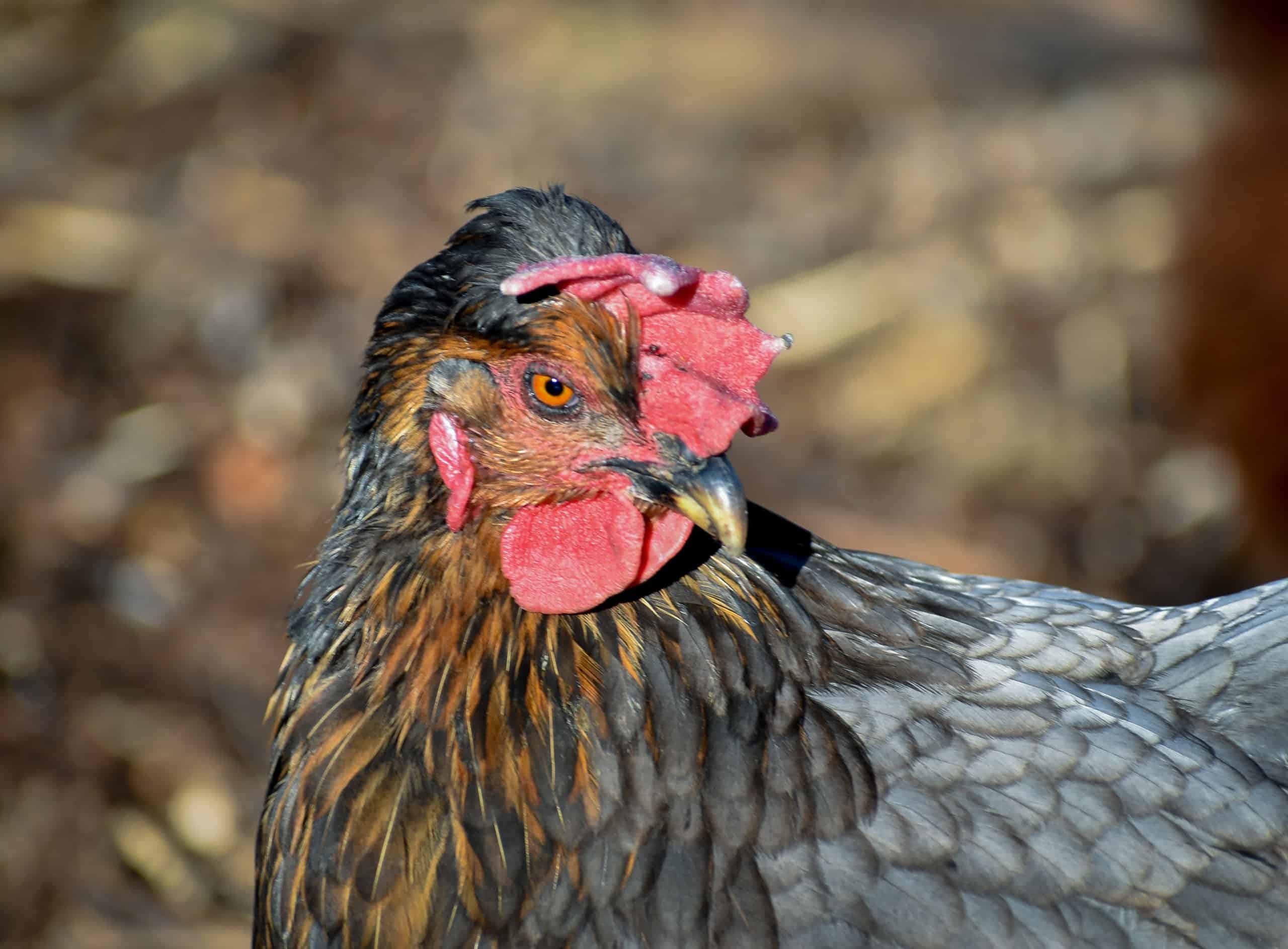Folks looking for a great egg-laying breed of chicken may wonder about the popular Sapphire gem chickens. Plenty of reasons exist for this craze, but knowing whether or not these beautiful birds are for you could be complicated. That’s what this guide is for.
Read below to learn everything you need to know about Sapphire gems to make your decision. These birds offer friendly personalities, good looks, and amazing eggs. They’re good for kids, good for urban and suburban yards, and good birds for good meat.
Sapphire Gem Chickens: Appearance
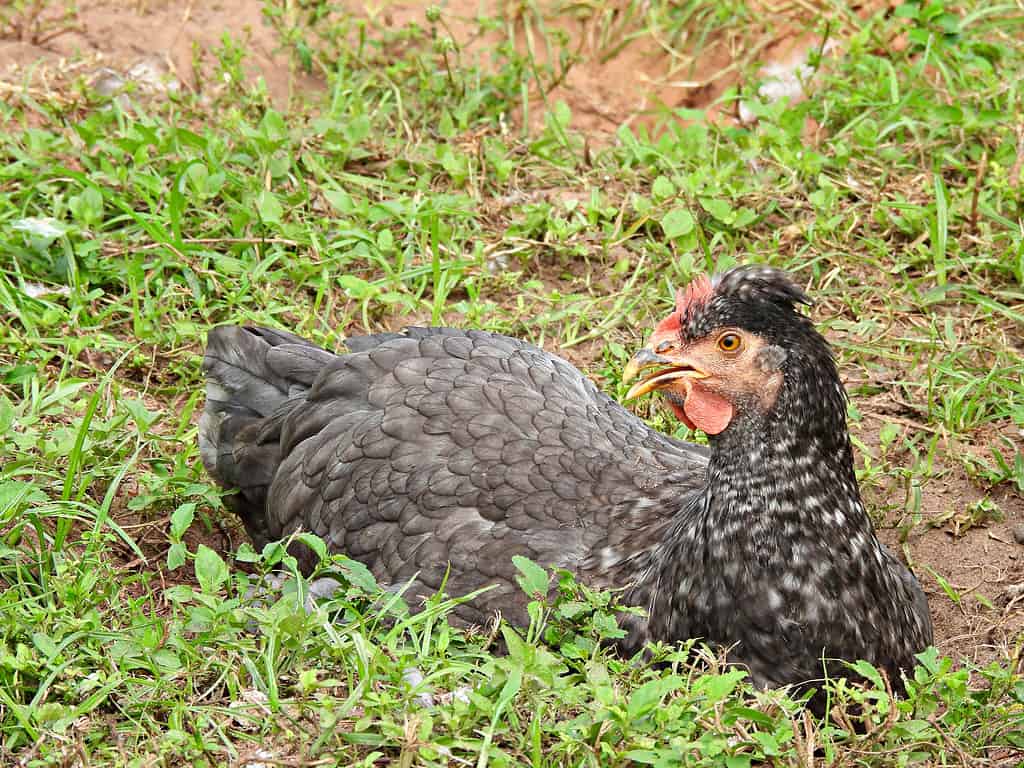
Sapphire gems have lavender to blue coloration.
©passion4nature/ via Getty Images
One of the largest draws of Sapphire gems cannot be denied: their appearance. However, these medium-sized chickens offer more than good looks. They are great egg layers and enjoy spending time with their people.
Weight
Roosters typically grow to about five pounds. Hens reach four pounds, on average. This means the birds are fairly average in size for chickens and they are considered medium-sized chickens.
Comb
Rooster combs are bright red, while female combs are smaller in size and more muted.
Colors
One thing that attracts many folks to raising these birds is the coloration found in Sapphire gem chicken feathers. These are the only chickens in which both males and females have blue to lavender colors as their main shade.
When born, males have a white dot on their heads or wings. Females look identical otherwise. The dots grow more prominent in males when they reach maturity. Females develop gray or gold feather patches on their necks.
Comparisons to Similar Breeds
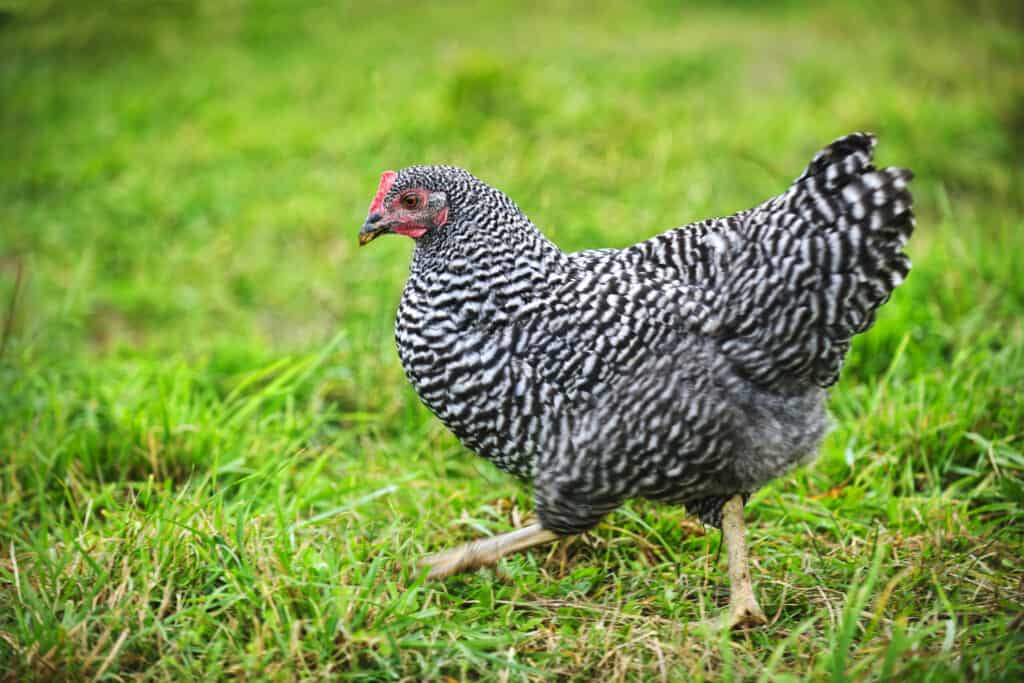
You can see a bit of resemblance to the Plymouth Rock chicken, one of the two breeds that helped create Sapphire gems.
©iStock.com/Elenathewise
Sapphire gem chickens are the only breed to have lavender to blue feathering as the main body color. Otherwise, their weight and size could be compared to that of the Plymouth Rock chicken breed and other medium-sized chicken breeds.
Maturation and Lifespan
The average lifespan for Sapphire gem chickens runs between five and ten years. Their quality of life, the quality of food, and the exclusion of predators and accidents, of course, impact this. Hens often begin laying eggs as early as four to six months of age, with full maturity reached by that time.
Temperament and Behavior
For folks looking for birds that double as pets and egg producers, the Sapphire gem chicken is your best bet. These beautiful birds show off unique, fun personalities with a lot of character. They are generally docile and charming, friendly and curious. They love to explore their surroundings and hang out with their humans.
Sapphire gem chickens are also highly adaptable and get along with other breeds as well as others of their own breed. They are highly social, though, so should never be kept as solo birds and require frequent human interactions to keep them healthy and happy.
How Noisy are Sapphire Gems?
Thankfully, Sapphire gems are not particularly loud birds. They’re generally calm, as well, which means they don’t sound the alarm over every little thing. Because of this, they are often chosen for urban and suburban flocks. Ideally, though, only keep hens if you need to keep things quieter. Roosters still crow.
Are Sapphire Gems Good for Kids?
Friendly-natured Sapphire gem chickens are wonderful pets for kids. Their beauty helps to intrigue children learning to care for animals. The social natures of these birds keep them affectionate and attentive to their humans. Having docile, adaptable demeanors only helps, as kids aren’t always great at showing proper respect for animals who are aggressive.
Sapphire Gem Chicken Health Concerns
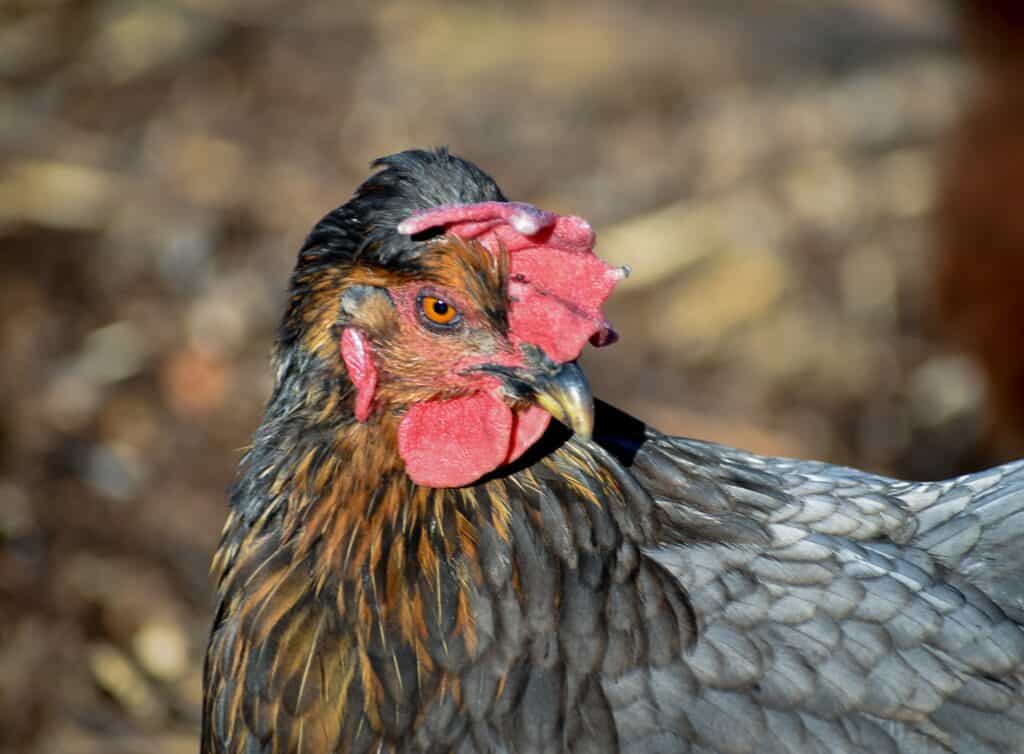
Sapphire gems have large, floppy combs that need protection from frostbite in winter.
©NPF Photography/Shutterstock.com
For happy, healthy lives, Sapphire gems need a high protein, balanced diet, plenty of fresh water, and socialization. They also need enough space to move around and keep active and a safe place for shelter and sleep. These things will keep them healthy. However, these hardy birds may still face health issues on occasion.
Potential Health Issues
Generally speaking, Sapphire gems are healthy, hardy birds with fewer health issues than many other chicken breeds. They do need regular health checks, though, to make sure they remain injury and illness-free.
These birds are prone to lice, parasites, and worms, just like other chickens. Treat the chickens with preventative care measures regularly. If you see any signs of these pests in your birds, you need to remove infected birds from the rest of the flock immediately. The best way to keep these pests away is to keep your chicken coop clean and provide clean, healthy food and water regularly.
In cooler months, you also need to make sure your birds are kept warm to protect their combs from frostbite. When frostbitten, combs may fall off. You can also apply Petroleum Jelly to care for the combs in winter.
Sapphire Gem Chicken Ease of Care
When given the opportunity to roam and socialize, Sapphire gem chickens remain happy and healthy, in most cases. This means that they’re fairly easy to care for. The primary concerns are keeping them warm in winter, keeping their coops clean, and providing them with high-protein, well-balanced diets.
Feeding Schedules and Amounts
When it comes to diet, the main difference between Sapphire Gems and other chickens is that these birds require higher protein foods than many other breeds. Younger Sapphire gems need even higher protein as they grow rapidly.
Look for 18% to 24% protein in their earliest foods. Once the hens begin laying eggs, though, they should be switched over to adult chicken food with high protein.
Do Sapphire Gem Chickens Get Along Well with Each Other?
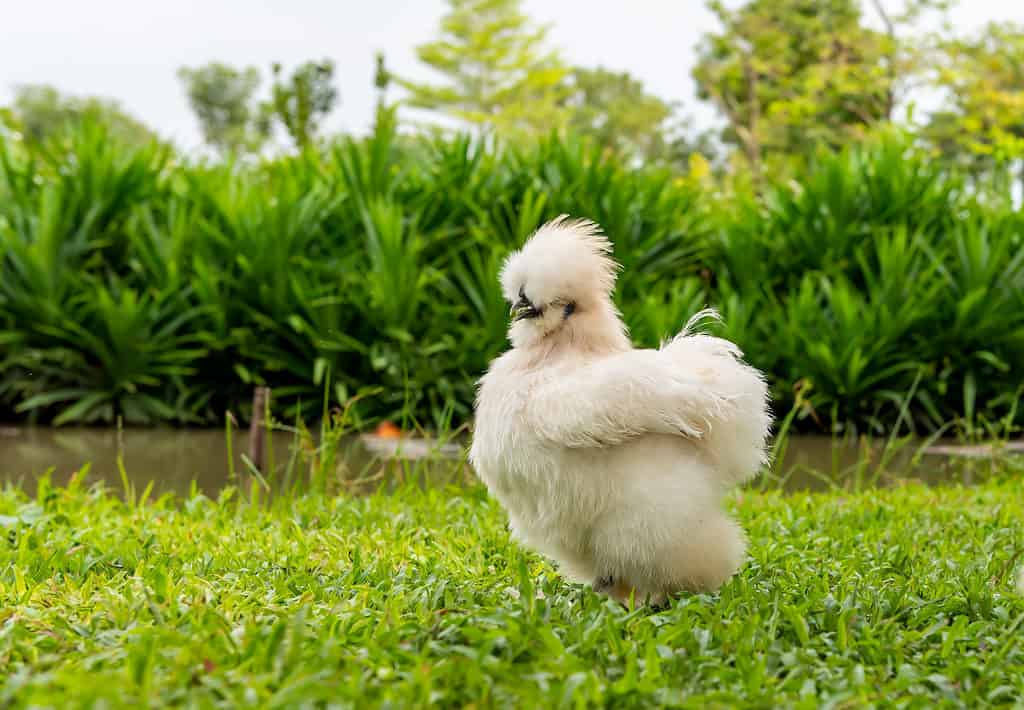
Sapphire gems and Silkie chickens get along marvelously.
©MR. AEKALAK CHIAMCHAROEN/Shutterstock.com
Sapphire gem chickens are highly social animals. They enjoy puttering around with their humans (kids included) and other birds. They thrive in flocks with other Sapphire gems, as well as other non-aggressive chicken breeds. They even get along with other pets, as long as they aren’t too large.
Some good companion breeds for Sapphire gem chickens include:
- Plymouth Rock chickens
- Silkie chickens
- Cochin chickens
- Speckled Sussex chickens
- Buff Orpington chickens
Sapphire Gem Chicken Coop Setup
For every Sapphire gem chicken, the coop needs roughly 8 square feet of space. This allows the birds to scratch and move about with ease, without getting overcrowded. Their coops should have a caged enclosure area for this movement, as well as an enclosed chicken house for roosting, nesting, and laying.
The right setup includes:
- Roosting bars indoors and outdoors
- Insulation to keep the chicken house warm
- Nesting boxes
- Lighting
- Warmers for cold weather
- Proper ventilation
- Dust or dirt areas for dust baths (these help them stay healthy)
Pros and Cons of Owning Sapphire Gems
Sapphire Gem chickens have many pros and cons in their upbringing, so you’ll want to consider these before bringing these birds home.
Pros
- These hens produce loads of eggs every year, as long as they’re healthy and fed well.
- If you like brown eggs, you’re in luck. That’s the color these birds lay.
- Sapphire gem chickens have friendly, affectionate personalities, making them enjoyable to care for.
- The birds are beautiful, which never hurts!
- Sapphire gem chickens tend to be healthy and hardy when well cared for.
Cons
- Because they lay so many eggs, they don’t work as meat chickens after their laying viability has passed.
- They tend to be expensive.
- Sapphire gem chickens are often difficult to find for sale.
- The egg production of Sapphire gem chickens requires more feed than some other breeds.
If you can find them, Sapphire gem chickens generally have more pros than cons, which is part of why they’re so popular.
Sapphire Gem Eggs
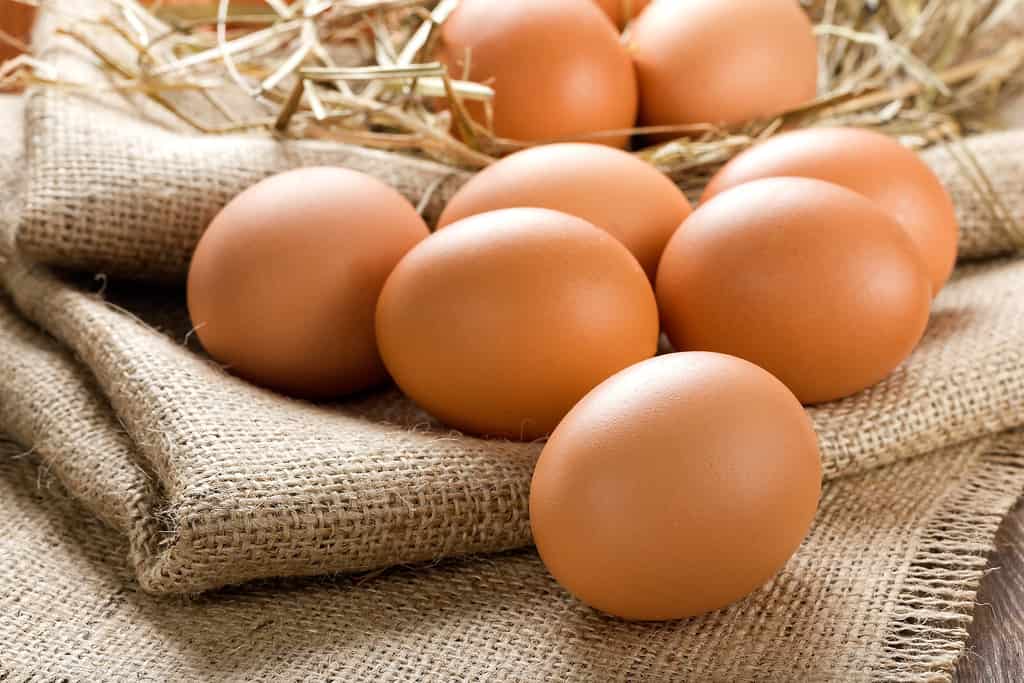
The eggs of Sapphire gems are tasty and brown. Each hen lays around 5 eggs per week.
©Sea Wave/Shutterstock.com
Sapphire gem chickens lay large, brown eggs. Typically, these hardy birds can each lay around 280 eggs per year, when healthy and fed properly. Usually, this means the hens will lay around 5 eggs per week, once the birds reach 6 months.
Thank you for reading! Have some feedback for us? Contact the AZ Animals editorial team.

